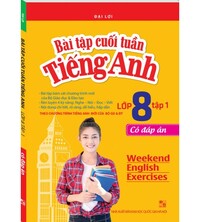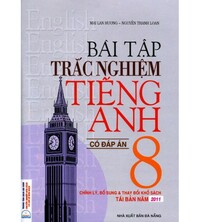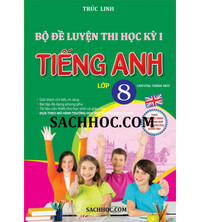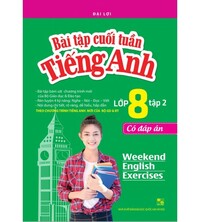Tiếng Anh 8 Unit 7 7.1 Vocabulary
1. Match the pictures of the different ethnic groups in Việt Nam with their names. 2. Listen and read the dialogue. Answer the questions. 3. Study the highlighted words in the dialogue in Exercise 2. Complete the Vocabulary box below. 4. Choose the correct form of the words given to complete the sentences. 5. Choose the correct phrases from the list given to complete the sentences.
Bài 1
1. Match the pictures of the different ethnic groups in Việt Nam with their names.
(Nối hình ảnh của các dân tộc khác nhau ở Việt Nam với tên của họ.)

Lời giải chi tiết:
1. Kinh
2. H’mông
3. Dao
4. Mường
5. Thái
6. Tày
Bài 2
2. Listen and read the dialogue. Answer the questions.
(Nghe và đọc đoạn đối thoại. Trả lời các câu hỏi.)
Tom: I saw a TV special about Việt Nam’s diverse ethnic minority groups. It said they are about 15% of the population in Việt Nam.
Lan: Yes, that’s right. Most of them live by traditional farming practices in mountainous areas.
Tom: It said they are grouped by their language. So, is their language different from Vietnamese?
Lan: Yes, that’s correct. Each group will have their own language.
Tom: I see. I really like their traditional costumes.
Lan: Right, they have very colourful costumes. They wear these to keep their ethnic identity. Their culture is also connected to the forests.
Tom: That’s interesting. I didn’t realize Việt Nam had so much cultural diversity.
1. Where do ethnic minority groups in Việt Nam often live? (Các dân tộc thiểu số ở Việt Nam thường sống ở đâu?)
2. What does Tom like about the ethnic minority groups? (Tom thích điều gì về các nhóm dân tộc thiểu số?)
Lời giải chi tiết:
1. Most of them live by traditional farming practices in mountainous areas. (Phần lớn họ sống bằng tập quán canh tác truyền thống ở miền núi.)
2. Tom really likes their traditional costumes. (2. Tom thực sự thích trang phục truyền thống của họ.)
Tạm dịch:
Tom: Tôi đã xem một chương trình truyền hình đặc biệt về các nhóm dân tộc thiểu số đa dạng của Việt Nam. Nó cho biết họ chiếm khoảng 15% dân số ở Việt Nam.
Lan: Vâng, đúng vậy. Phần lớn họ sống bằng tập quán canh tác truyền thống ở miền núi.
Tom: Nó nói rằng họ được nhóm theo ngôn ngữ của họ. Vậy ngôn ngữ của họ có khác tiếng Việt không?
Lan: Vâng, đúng vậy. Mỗi nhóm sẽ có ngôn ngữ riêng.
Tom: Tôi hiểu rồi. Tôi thực sự thích trang phục truyền thống của họ.
Lan: Đúng rồi, họ có trang phục rất sặc sỡ. Họ mặc những thứ này để giữ bản sắc dân tộc của họ. Văn hóa của họ cũng được kết nối với các khu rừng.
Tom: Điều đó thật thú vị. Tôi đã không nhận ra Việt Nam có nhiều sự đa dạng về văn hóa.
Bài 3
3. Study the highlighted words in the dialogue in Exercise 2. Complete the Vocabulary box below.
(Nghiên cứu những từ được đánh dấu trong đoạn hội thoại ở Bài tập 2. Hoàn thành ô Từ vựng bên dưới.)
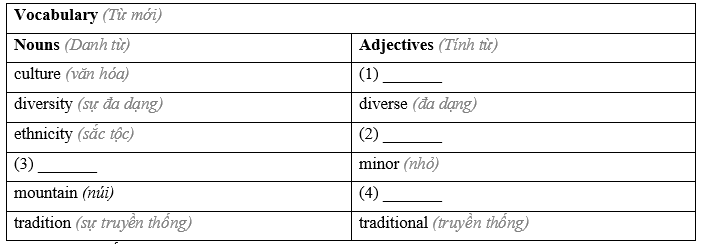
Lời giải chi tiết:
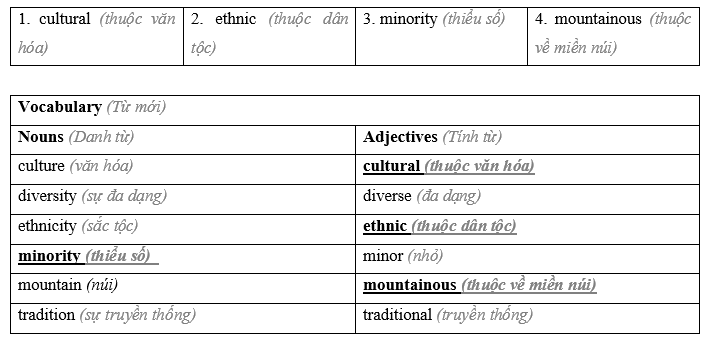
Bài 4
4. Choose the correct form of the words given to complete the sentences.
(Chọn dạng đúng của các từ cho sẵn để hoàn thành câu.)
1. I find the culture / cultural of the Red Dao very interesting.
2. Việt Nam has 54 ethnicity / ethnic groups. Do you know them all?
3. You will travel through some mountain / mountainous roads in Lạng Sơn.
4. The Tày and Thái people are among minor / minority groups in Việt Nam that have their ơn language.
5. The tradition / traditional of making five-coloured sticky rice is still done in certain areas.
Lời giải chi tiết:

1. I find the culture of the Red Dao very interesting. (Tôi thấy văn hóa của người Dao đỏ rất thú vị.)
2. Việt Nam has 54 ethnic groups. Do you know them all? (Việt Nam có 54 dân tộc anh em. Bạn có biết tất cả?)
3. You will travel through some mountainous roads in Lạng Sơn. (Bạn sẽ đi qua một số con đường miền núi ở Lạng Sơn.)
4. The Tày and Thái people are among minority groups in Việt Nam that have their own language. (Người Tày và người Thái là một trong những nhóm dân tộc thiểu số ở Việt Nam có ngôn ngữ riêng.)
5. The tradition of making five-coloured sticky rice is still done in certain areas. (Truyền thống làm xôi ngũ sắc vẫn còn ở một số vùng.)
Bài 5
5. Choose the correct phrases from the list given to complete the sentences.
(Chọn các cụm từ đúng từ danh sách được đưa ra để hoàn thành các câu.)
a. cultural diversity (sự đa dạng văn hóa)
b. ethnic identity (bản sắc dân tộc)
c. ethnic minority groups (nhóm dân tộc thiểu số)
d. mountainous areas (khu vực miền núi)
e. traditional (farming) practices (tập quán (nông nghiệp) truyền thống)
f. traditional costumes (trang phục truyền thống)
1. The _______ in Việt Nam have their own languages.
2. We travelled through the _______ to get to Sa Pa.
3. You will see people wearing their _______ in Bắc Hà Market.
4. Parents in villages are trying to pass on their _______ to their children.
5. There is a lot of _______ in some parts of Việt Nam.
6. Many people in the H’mông group still use _______ to grow rice.
Lời giải chi tiết:

1. The cultural diversity in Việt Nam have their own languages. (Sự đa dạng về văn hóa ở Việt Nam có ngôn ngữ riêng.)
2. We travelled through the mountainous areas to get to Sa Pa. (Chúng tôi đi xuyên qua các vùng núi để đến Sa Pa.)
3. You will see people wearing their traditional costumes in Bắc Hà Market. (Bạn sẽ thấy mọi người mặc trang phục truyền thống của họ ở chợ Bắc Hà.)
4. Parents in villages are trying to pass on their ethnic identity to their children. (Các bậc cha mẹ trong làng đang cố gắng truyền lại bản sắc dân tộc của họ cho con cái của họ.)
5. There is a lot of ethnic minority groups in some parts of Việt Nam. (Có nhiều nhóm dân tộc thiểu số ở một số vùng của Việt Nam.)
6. Many people in the H’mông group still use traditional (farming) practices to grow rice. (Nhiều người trong nhóm H’mông vẫn sử dụng các tập quán (canh tác) truyền thống để trồng lúa.)
Bài 6
6. Look at the pictures in Exercise 1 again. In pairs, tell your partner about one of the ethnic groups in Việt Nam.
(Nhìn lại những hình ảnh trong Bài tập 1. Theo cặp, nói với đối tác của bạn về một trong các nhóm dân tộc ở Việt Nam.)
The H’mông people of Việt Nam have their own language and food. For example, … (Người H’mông ở Việt Nam có ngôn ngữ và thức ăn riêng. Ví dụ, …)
Lời giải chi tiết:
The Kinh people of Việt Nam usually wear áo dài when they have special occasion. (Người Kinh của Việt Nam thường mặc áo dài khi họ có dịp đặc biệt.)
Search google: "từ khóa + timdapan.com" Ví dụ: "Tiếng Anh 8 Unit 7 7.1 Vocabulary timdapan.com"
